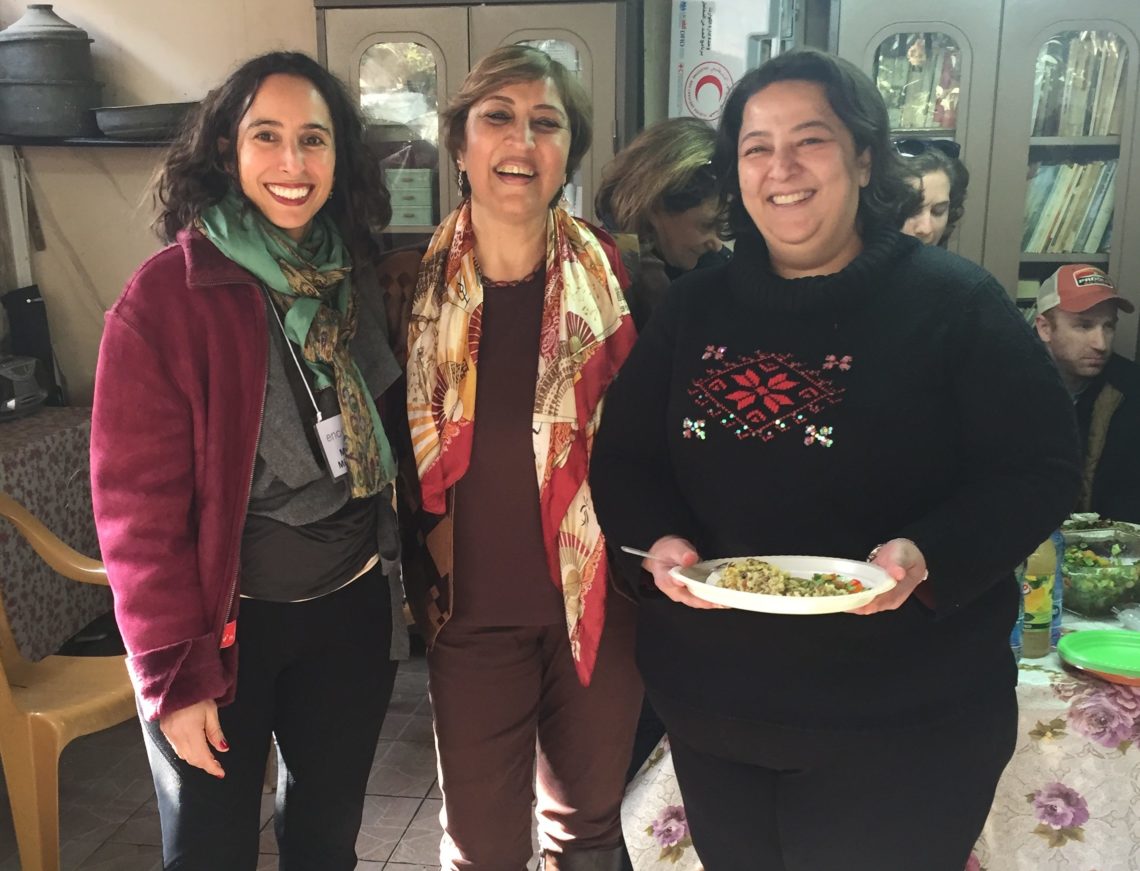 Amal Alquasem Abuhasnah, Director of Women’s Forun of Sheik Jarra. Photo courtesy of the author
Amal Alquasem Abuhasnah, Director of Women’s Forun of Sheik Jarra. Photo courtesy of the author Recently, I returned from a four-day intensive trip to East Jerusalem, Bethlehem and Ramallah with 24 Jewish leaders from around North America through a program called Encounter (www.encounterprogams.org). Members of the group came from a variety of professions: congregational Rabbis (Reform, Conservative, Reconstructionist & Orthodox); Hillel leaders; media editors (The Forward, The Wall Street Journal, Bimbam.com); Israeli advocacy groups (The David Project, JCRC, Israel Action Network); The ADL; The Bronfman Foundation; The Wexner Foundation; The Shalom Hartman Institute; Federation leaders from San Francisco and Boston; philanthropists; leaders of Jewish seminaries; and a prolific writer in the Jewish world.
The stated goal of our four day trip into the West Bank was to participate in a “listening campaign” to deeply listen to, and not argue with, the stories of the Palestinian people we met. I understood this goal of listening (in Hebrew, Shema) as a challenge to honor the stories I encountered, not necessarily feel I had to agree or disagree with them. It was a given that as Jewish leaders, all of us understood that there are a variety of Jewish voices (from Israel and America) concerning the Palestinian-Israeli conflict. What many of us, including myself, don’t often have the opportunity to hear, is the range of Palestinian voices concerning the Israeli-Palestinian conflict. Our goal was to hear these Palestinian narratives, from three cities, on their turf. We didn’t meet with any Palestinians from Gaza, or from Israel itself (According to the Palestinian Central Bureau of Statistics, there are some 1.9 million Palestinians living in Gaza, 2.9 million in the West Bank and 1.75 million Israeli Arabs.)
I would like to introduce you to some of the people I met, the stories I heard, and my reactions to their stories. Please meet:
Lama Abuarquob, Hebron activist, an English teacher in Palestinian H.S. (Dar Essalaam Girls H.S.), teaching for 23 years
Lama told us that the morning we met her, she was teaching her students about antonyms. A 17-year old said: “I get it, you mean, for example: good and bad, or Palestinians and Israelis.” She stopped the conversation and said, “No, we can’t label people like that.” On the other hand, she shared that her son’s 9th grade teacher recently told her students that they should, “Use whatever force you can or else you are a non-believer.” When describing the environment at her school, she said that of the 250 girls, only 6 or 7 don’t wear head scarves, and when she and her husband sent her daughter to study for a semester in Arizona, they were criticized by their community.
Abu Ibrahim, head of the village of Khalet Zakariya
In his 70s, Abu serves as the village elder. About 650 Palestinians live in Khalet Zakariya, which is in Zone C (an area in the West Bank, fully controlled by Israel). The village is surrounded by 5 Jewish settlements. Though his village legally applied for building permits in 2005 along with a master plan, according to him, Israel has not issued building permits for his village since 1967. Often people in his village live 5 per room. They eventually give up waiting for permits and just build “illegally.” Their homes look like simple bricks with a metal roof. Abu reported that currently there are 33 demolition orders for his village. It was upsetting to see that across the road, on the nearby hill, sits a Jewish settlement with beautiful homes and a large school. In his closing words Abu said, “We have no problems with Jews, Christians, Hindus… we just want a dignified life. I wish all politicians would just say ‘enough is enough.’”
Abu Fatach, Director of the Cultural Center in Aida Refugee Camp
Abu Fatach earned his PhD in France. He was born in the Aida Refugee camp. These camps were opened by the United Nations in 1948 on rented land (99 years) to be a temporary place where Palestinians could live until the refugee problem was settled. (See UN Resolution 194). Many Palestinians have since left these camps, which are poorly run by the UN and provide sub-par health and educational services. When asked why he doesn’t leave and create a better life for himself elsewhere, like hundreds of thousands of refugees are doing around the world, Abu replied, “Being denied my right to return is infuriating. It should be up to me where I want to live or return to. I want the right to determine my situation. To ask me to get used to it [Israeli occupation of the home he feels is his in Israel] after 69 years of occupation doesn’t work for me. The UN resolution 194 said we can return and Israel is not acting legally. They [Israel] perform one injustice after another.” His closing words were, “There is no possibility of a two state solution anymore. I would like one country with equal rights for all, regardless of religion. Once we recognize each other as equals then we can probably live with each other. We don’t have the luxury of despair.”
Amal Alquasem Abuhasnah, 55 year old Palestinian woman, born and raised in Sheik Jarra (a neighborhood in East Jerusalem) and director of Women’s Forum of Sheik Jarrah
Amal shared that Sheik Jarrah was built with Jordanian money in 1948 for Palestinians who were fleeing West Jerusalem. In 1948, Jordan owned East Jerusalem and Israel owned West Jerusalem. Through a lottery, 28 families were given new homes by Jordan, and Amal’s grandfather was one of those families.
By moving to East Jerusalem, Amal and her family lost their refugee status but gained an East Jerusalem identity. (East Jerusalem identity does NOT mean she has Israeli citizenship. She could have applied for that in 1948, but did not). She does not vote in Jerusalem municipal elections, even though she could, because she believes that would be legitimizing the Israeli government. During the Six Day War (1967), Israel captured East Jerusalem, including Sheikh Jarrah. In 1972, the Sephardic Community Committee and the Knesset Yisrael Committee went to court to reclaim the property in the neighborhood.
In 1982, these Jewish groups demanded rent for this property and the Supreme Court of Israel ruled in their favor. Amal and other Palestinian tenants were allowed to remain in their homes as long as they paid rent. However they refused to pay rent. She explained that this is her home. She is now constantly scared that Israeli settlers will kick her out of her home, as they have done to two of her neighbors. A 90-year-old Palestinian woman resides across the street. Three times, her son asked for building permits to build a home in front of his mother’s home so he could move in with his family and care for her. Three times the city said no, and gave no reason. He built his small home anyway. After he and his family moved in, Jewish settlers banged on his door and forced them to leave. Now the settlers are living in the front home and the 90-year-old is living in the back home. Also, the home next door was attacked one night after midnight by settlers. They forced the family to leave their home. The next morning, settlers moved into this home. During this night raid, they also placed Jewish guards outside of every Palestinian home and intimidated them by saying that they shouldn’t dare leave their homes to help these Palestinians, because then the same thing would happen to them. In closing, Amal said, “It’s not easy to define what it means to be a Palestinian. We were once simple people. It was a quiet and golden time. After the occupation we became a different people. On the one hand, we want to keep our gentle, simple, sweetness. On the other hand, we need to be very strong and conservative. Before the occupation, we didn’t have negative feelings toward other peoples, but now we do.”
The Palestinians I spoke with are angry. They feel that the occupation equals oppression and creates an environment that lacks dignity. They feel like they are treated like animals in cages (not allowed to travel freely), they are invisible (like when they apply for building permits and are ignored), and they are disrespected (like when they have to wait in line for three hours in the morning to get through the security barrier to go to work in Israel). It is my personal belief that continuing to not give the Palestinian people their own land is bad for the Jewish soul. I feel that it is dirtying our people and our religion. The more stories I heard on my four days of listening in East Jerusalem, Bethlehem and Ramallah, the more embarrassed I felt as a Jew. I believe that fighting for a two-state solution is our only hope and that it is our obligation as Jews to treat others with dignity.






















 More news and opinions than at a Shabbat dinner, right in your inbox.
More news and opinions than at a Shabbat dinner, right in your inbox.